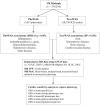Genetically determined serum urate levels and cardiovascular and other diseases in UK Biobank cohort: A phenome-wide mendelian randomization study
- PMID: 31626644
- PMCID: PMC6799886
- DOI: 10.1371/journal.pmed.1002937
Genetically determined serum urate levels and cardiovascular and other diseases in UK Biobank cohort: A phenome-wide mendelian randomization study
Abstract
Background: The role of urate in cardiovascular diseases (CVDs) has been extensively investigated in observational studies; however, the extent of any causal effect remains unclear, making it difficult to evaluate its clinical relevance.
Methods and findings: A phenome-wide association study (PheWAS) together with a Bayesian analysis of tree-structured phenotypic model (TreeWAS) was performed to examine disease outcomes related to genetically determined serum urate levels in 339,256 unrelated White British individuals (54% female) in the UK Biobank who were aged 40-69 years (mean age, 56.87; SD, 7.99) when recruited from 2006 to 2010. Mendelian randomization (MR) analyses were performed to replicate significant findings using various genome-wide association study (GWAS) consortia data. Sensitivity analyses were conducted to examine possible pleiotropic effects on metabolic traits of the genetic variants used as instruments for urate. PheWAS analysis, examining the association with 1,431 disease outcomes, identified 13 distinct phecodes representing 4 disease groups (inflammatory polyarthropathies, hypertensive disease, circulatory disease, and metabolic disorders) and 9 disease outcomes (gout, gouty arthropathy, pyogenic arthritis, essential hypertension, coronary atherosclerosis, ischemic heart disease, chronic ischemic heart disease, myocardial infarction, and hypercholesterolemia) that were associated with genetically determined serum urate levels after multiple testing correction (p < 3.35 × 10-4). TreeWAS analysis, examining 10,750 ICD-10 diagnostic terms, identified more sub-phenotypes of cardiovascular and cerebrovascular diseases (e.g., angina pectoris, heart failure, cerebral infarction). MR analysis successfully replicated the association with gout, hypertension, heart diseases, and blood lipid levels but indicated the existence of genetic pleiotropy. Sensitivity analyses support an inference that pleiotropic effects of genetic variants on urate and metabolic traits contribute to the observational associations with CVDs. The main limitations of this study relate to possible bias from pleiotropic effects of the considered genetic variants and possible misclassification of cases for mild disease that did not require hospitalization.
Conclusion: In this study, high serum urate levels were found to be associated with increased risk of different types of cardiac events. The finding of genetic pleiotropy indicates the existence of common upstream pathological elements influencing both urate and metabolic traits, and this may suggest new opportunities and challenges for developing drugs targeting a common mediator that would be beneficial for both the treatment of gout and the prevention of cardiovascular comorbidities.
Conflict of interest statement
The authors have declared that no competing interests exist.
Figures



References
-
- Li X, Meng X, Timofeeva M, Tzoulaki I, Tsilidis KK, Ioannidis JP, et al. Serum uric acid levels and multiple health outcomes: umbrella review of evidence from observational studies, randomised controlled trials, and Mendelian randomisation studies. BMJ. 2017;357:j2376 10.1136/bmj.j2376 - DOI - PMC - PubMed
Publication types
MeSH terms
Substances
Grants and funding
LinkOut - more resources
Full Text Sources

